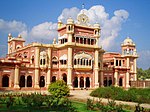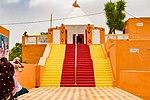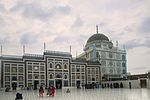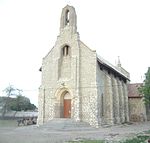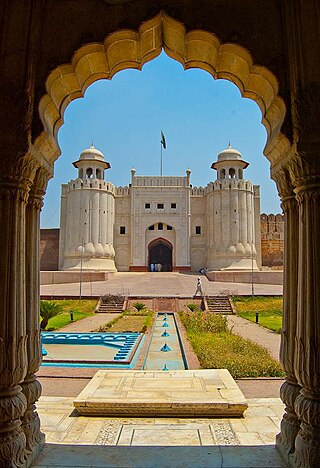Protected sites
Following is the list of sites formerly protected by the Government of Pakistan.
Districts: Badin to Jamshoro
| ID | Name | Type | Location | District | Coordinates | Image |
|---|---|---|---|---|---|---|
| SD-1 | Ruins of old city | Badin | Badin |  | ||
| SD-2 | Jami Masjid | Khudabad | Dadu |  | ||
| SD-3 | Tomb of Yar Muhammad Khan Kalhora and mosque | near Khudabad | Dadu | 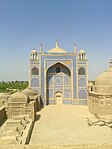 | ||
| SD-4 | Amri Mounds | Dadu |  | |||
| SD-5 | Lakhomir-ji-Mari (Lakhmir Mound) | Deh Nang opposite Police outpost, Sehwan | Dadu |  | ||
| SD-6 | Damb Buthi | Deh Narpirar at the source of the pirari (spring), south of Jhangara, Sehwan | Dadu |  Upload Photo | ||
| SD-7 | Piyaro ji Mari | Deh Dhaunk near pir Gaji Shah, Johi | Dadu |  | ||
| SD-8 | Ali Murad village mounds | Deh Bahlil Shah, Johi | Dadu |  | ||
| SD-9 | Nasumji Buthi | Deh Karchat Mahal, Kohistan | Dadu |  Upload Photo | ||
| SD-10 | Kohtrass Buthi | Deh Karchat about 8 miles south-west of village of Karchat on road from Thana Bula Khan to Taung | Dadu |  | ||
| SD-11 | Othamjo Buthi | Deh Karchat or river Baran on the way from the Arabjo Thano to Wahi village north-west of Bachani sandhi, Mahal, Kohistan | Dadu |  Upload Photo | ||
| SD-12 | Lohamjodaro | Deh Palha at a distance of 30 chains from Railway Station but not within railway limits | Dadu |  | ||
| SD-13 | Pandhi Wahi village mounds | Deh Wahi, Johi | Dadu | 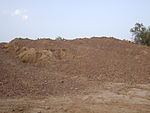 | ||
| SD-14 | Ancient Mound | Deh Wahi Pandhi, Johi | Dadu |  | ||
| SD-15 | Tomb of Mian Ghulam Kalhoro | Hyderabad |  | |||
| SD-16 | Wall of Kacha Qilla | Hyderabad |  | |||
| SD-17 | Old office of Mirs | Hyderabad Fort | Hyderabad |  Upload Photo | ||
| SD-18 | Tajar (Treasury) of Mirs | Hyderabad Fort | Hyderabad |  Upload Photo | ||
| SD-19 | Tomb of Ghulam Nabi Khan Kalhora | Hyderabad |  | |||
| SD-20 | Buddhist Stupa | (Guja) a few miles from Tando Muhammad Khan | Hyderabad |  Upload Photo | ||
| SD-21 | Haram of Talpur Mirs | Hyderabad |  | |||
| SD-22 | Tombs of Talpur Mirs | Hirabad | Hyderabad |  | ||
| SD-23 | Tower (Now used as water tank) | Hyderabad Fort | Hyderabad |  | ||
| SD-24 | Mosques and tomb | Tando Fazal | Hyderabad | 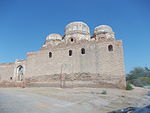 | ||
| SD-25 | Tomb of Sarfaraz Khan Kalhora | Hyderabad |  | |||
| SD-26 | Nasar-ji- Mosque | Mohalla Jhambhas, Nasarpur | Hyderabad |  | ||
| SD-27 | Kiraiji Masjid | Mohalla Misri, Nasarpur | Hyderabad |  Upload Photo | ||
| SD-28 | Mai Khairi Masjid | Mohalla Memon | Hyderabad |  | ||
| SD-29 | Mosque of Mirs | Hyderabad city | Hyderabad |  | ||
| SD-30 | Ranikot Fort | Jamshoro | 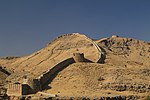 |
Karachi
Districts: Khairpur to Tharparkar
| ID | Name | Type | Location | District | Coordinates | Image |
|---|---|---|---|---|---|---|
| SD-37 | Diji ki Takri mound, remains of earliest fortified town | Deh Ghaunro near Kot Diji Fort | Khairpur |  Upload Photo | ||
| SD-38 | Kot Diji Fort | Kot Diji | Khairpur |  | ||
| SD-39 | Maro Waro Dhoro mound situated on sand hill | Deh Naro Dhoro 2 miles east of Tando Masti Khan | Khairpur |  Upload Photo | ||
| SD-40 | Jhukar mound | Mithadaro | Larkana |  | ||
| SD-41 | Buddhist Stupa | Mohenjo-daro | Larkana |  | ||
| SD-42 | The Great Bath of Moenjodaro | Mohenjo-daro | Larkana |  | ||
| SD-43 | All other remains at Moenjodaro | Moenjodaro | Larkana |  | ||
| SD-44 | Tajjar Building | Jinnah Bagh | Larkana |  | ||
| SD-45 | Tomb of Shah Baharo | Larkana |  | |||
| SD-46 | Square Tower | near Dhamrao | Larkana |  | ||
| SD-47 | Dhamrao Dero (three groups) | Deh Dhamrao, Deh 67 Nasrat | Larkana |  | ||
| SD-48 | Buddhist Stupa | Kahujodaro | Mirpurkhas |  | ||
| SD-49 | Buddhist Stupa | Village Mir Rukan | Nawabshah |  | ||
| SD-50 | Tomb of Nur Muhammad Kalhora | Deh of Village Nur Muhammad, 17 miles from Daulatpur | Nawabshah |  | ||
| SD-51 | Qubbo Mir Shahadad | Shahpur | Nawabshah |  | ||
| SD-52 | Bhiro Bham Mound | Tepa Chibore | Nawabshah |  Upload Photo | ||
| SD-53 | Brahmanabad (Mansura) locally known as Dalo Raja-ji-Nagri | Jamara, Tehsil Sinjhoro, Deh Dalore | Sanghar |  Upload Photo | ||
| SD-54 | Mound Thulh | Deh Kot Bujar | Sanghar |  Upload Photo | ||
| SD-55 | Graveyard | Tehsil Shahdadpur | Sanghar |  Upload Photo | ||
| SD-55.5 | Landsdown Bridge | Rohri | Sukkur | 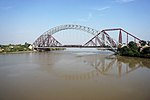 | ||
| SD-56 | Mir Masum's Minar and tomb | Sukkur |  | |||
| SD-57 | Sateen Jo Aastan | Rohri | Sukkur |  | ||
| SD-58 | Bakkar Fort entire area and the walls and tombs of Hazrat Sadruddin | Sukkur |  | |||
| SD-59 | Moomal Ji Mari | Taluka Ghotki, Deh Mathelo | Ghotki | 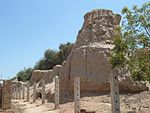 | ||
| SD-60 | Stone Tool Factory area | Rohri | Sukkur |  | ||
| SD-61 | Birthplace of Akbar the Great | near the town of Umerkot | Umerkot |  | ||
| SD-62 | A stone mosque with white marble pillars | Bhodesar | Tharparkar |  | ||
| SD-63 | Temple | Bhodesar | Tharparkar | 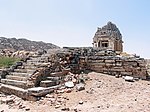 | ||
| SD-64 | Jain Temple | Nagarparkar | Tharparkar | 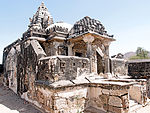 | ||
| SD-66 | Fort Umerkot outside | Umerkot |  | |||
| SD-67 | Fort Umerkot (inside) | Umerkot |  | |||
| SD-68 | Gori Temple | 14 miles north-west of Virawah | Tharparkar |  | ||
| SD-69 | Other temples | Bhodesar | Tharparkar | 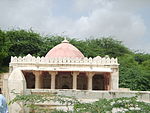 | ||
| SD-70 | Mound at Bhiro | Sherwah | Tharparkar |  Upload Photo | ||
| SD-71 | Mound at Shadi Pali | Deh Khuda Bux | Tharparkar |  Upload Photo | ||
| SD-72 | Jain Temple | Virawah | Tharparkar |  | ||
| SD-73 | Tomb of Tharo Khan | Chitorri | Mirpurkhas |  | ||
| SD-74 | Other tombs of the ruler of Mirpur Khas in Chitorri Graveyard | Chitorri | Mirpurkhas |  | ||
| SD-75 | Brick Tomb of Arzi Khokhar | Ghitori, Goth, Deh No. 24 | Tharparkar |  Upload Photo | ||
| SD-76 | Tomb of Mir Khan s/o Karam Khan Talpur | Ghitori Goth, Deh No. 24 | Tharparkar |  Upload Photo | ||
| SD-77 | Tomb of Mir Jado | Ghitori Goth, Deh No. 24 | Tharparkar |  Upload Photo | ||
| SD-78 | Tomb of Mir Murad Khan | Ghitori Goth, Deh No. 24 | Tharparkar | 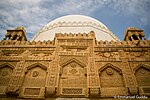 | ||
| SD-79 | Tomb of Musa Khan | Ghitori Goth, Deh No. 24 | Tharparkar |  Upload Photo | ||
| SD-80 | Tomb of Mir Raio | Ghitori Goth, Deh No. 24 | Tharparkar |  Upload Photo | ||
| SD-81 | Tomb of Shaheed Kapri Baloch | Ghitori Goth, Deh No. 24 | Tharparkar |  Upload Photo | ||
| SD-82 | Tombs near Shaheed Kapri Baluch | Ghitori Goth, Deh No. 24 | Tharparkar |  Upload Photo | ||
| SD-83 | Tombs of Mir Fateh Khan and Mir Mirza Khan | Ghitori Goth, Deh No. 24 | Tharparkar |  Upload Photo | ||
| SD-84 | Tomb of females of Mir dynasty | Ghitori Goth, Deh No. 24 | Tharparkar |  Upload Photo | ||
| SD-85 | Tomb of women of the Mir Dynasty | Ghitori Goth, Deh No. 24 | Tharparkar |  Upload Photo | ||
| SD-86 | Tomb of Aulia Pir Ghitori Badshah Qureshi | Ghitori Goth, Deh No. 24 | Tharparkar |  Upload Photo | ||
| SD-87 | Old mosque | Ghitori Goth, Deh No. 24 | Tharparkar |  Upload Photo | ||
| SD-88 | Naukot Fort | Naukot | Tharparkar |  | ||
| SD-89 | Churrio Jabal Durga Mata Temple | Churrio Jabal, Nangarparkar | Tharparkar |  |
Thatta
| ID | Name | Type | Location | District | Coordinates | Image |
|---|---|---|---|---|---|---|
| SD-89 | Port of Banbhore | Mirpur Sakro, the city ruins lie on the N-5 National Highway, east of Karachi | Thatta |  | ||
| SD-90 | Shah Jahan Mosque, Thatta | Makli Necropolis | Thatta |  | ||
| SD-91 | Overview of Makli Hill | Makli Necropolis | Thatta | |||
| SD-92 | Brick dome to the north-east of tomb of Mubarak Khan (tomb of Fateh Khan's sister) | Makli Necropolis | Thatta |  | ||
| SD-93 | Tomb of Mubarak Khan, son of Jam Nizamuddin | Makli Necropolis | Thatta |  | ||
| SD-94 | Jam Nizamuddin II's Tomb | Makli Necropolis | Thatta | 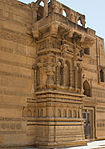 | ||
| SD-95 | Tombs, compound wall of yellow stone, pavilions on stone pillars over the tombs, tomb with superstructure on stone pillars, brick structure, all around the tomb of Jam Nizamuddin | Makli Necropolis | Thatta |  | ||
| SD-96 | Tomb of Sultan Ibrahim wrongly known a Amir Khalil Khan's tomb | Makli Necropolis | Thatta |  | ||
| SD-97 | Tomb and compound wall of yellow stone to the south of Mirza Muhammad Baqi Tarkhan tomb (wrongly called Mirza Isa Khan's tomb) | Makli Necropolis | Thatta |  | ||
| SD-98 | Brick enclosure of Mirza Baqi Baig Uzbak's tomb, south of the tomb of Nawab Isa Khan the Younger | Makli Necropolis | Thatta |  | ||
| SD-99 | Tomb of Nawab Isa Khan Tarkhan the Younger | Makli Necropolis [3] | Thatta |  | ||
| SD-100 | Diwan Shurfa Khan's tomb | Makli Necropolis [3] | Thatta |  | ||
| SD-101 | Brick mosque and enclosure near Nawab Shurfa Khan's tomb (supposed to be the tomb of Sayed Amir Khan) | Makli Necropolis | Thatta |  | ||
| SD-102 | Baradari | Makli Necropolis | Thatta |  Upload Photo | ||
| SD-103 | Tomb of Amir Sultan Muhammad, son of Amir Hajika | Makli Necropolis | Thatta |  | ||
| SD-104 | Mirza Tughral Baig's tomb | Makli Necropolis | Thatta | 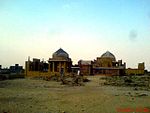 | ||
| SD-105 | Tomb of Mirza Jani and Mirza Ghazi Baig | Makli Necropolis | Thatta |  | ||
| SD-106 | Stone tomb with a dome on stone pillars by the side Mirza Jani Baig's tomb | Makli Necropolis | Thatta |  | ||
| SD-107 | Stone enclosure containing tombs of Nawab Isa Khan | Makli Necropolis | Thatta |  | ||
| SD-108 | Mirza Muhammad Baqi Tarkhan's tomb (wrongly called Mirza Isa Khan's tomb) | Makli Necropolis | Thatta |  | ||
| SD-109 | Stone tomb with enclosure to the south of tomb of Mirza Muhammad Baqi Tarkhan | Makli Necropolis | Thatta | 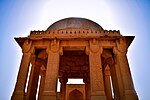 | ||
| SD-110 | Brick tomb near the tomb of Qulia pir | Makli Necropolis | Thatta | 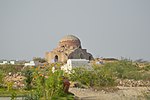 | ||
| SD-111 | Dabgir Masjid | Makli Necropolis | Thatta |  Upload Photo | ||
| SD-112 | Goth Raja Malik graveyard known as Maqam Qadar Shah | Deh Raja Malik | Thatta | 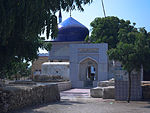 | ||
| SD-113 | Sonda graveyard | village Sonda | Thatta |  | ||
| SD-114 | Kalan Kot | Makli Necropolis | Thatta | 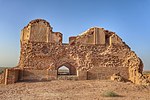 | ||
| SD-115 | Nawab Amir Khan's mosque | Makli Necropolis | Thatta |  Upload Photo | ||
| SD-116 | Building with two domes near the Civil Hospital | Makli Necropolis | Thatta |  Upload Photo | ||
| SD-117 | Jama Masjid | Makli Necropolis | Thatta |  | ||
| SD-118 | Sasian-Jo-Takar | Mirpur Sakro | Thatta |  Upload Photo |







